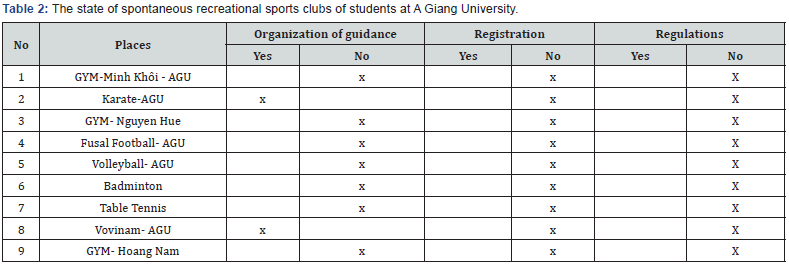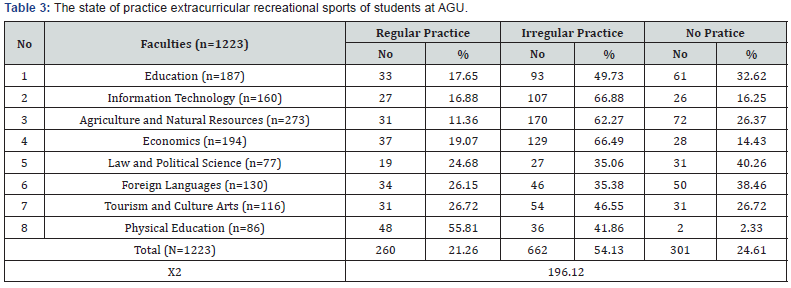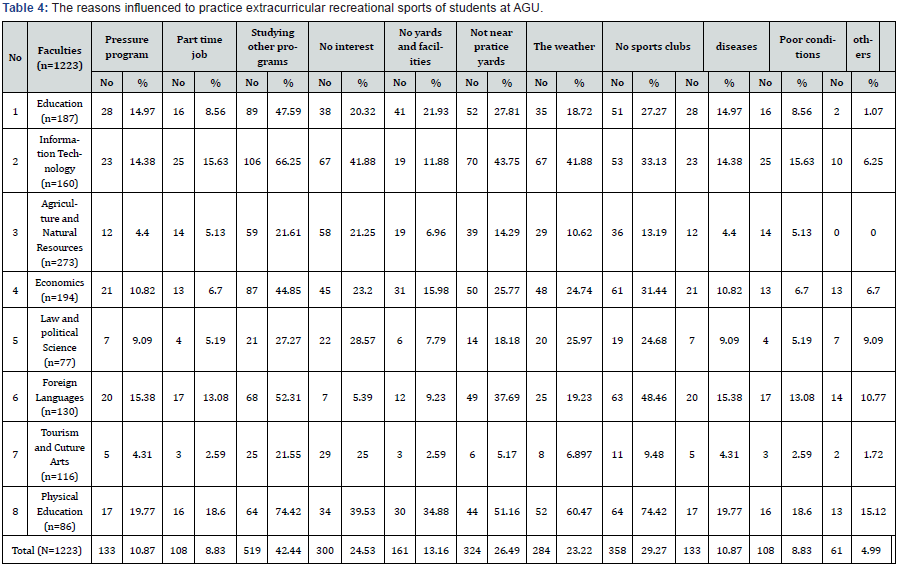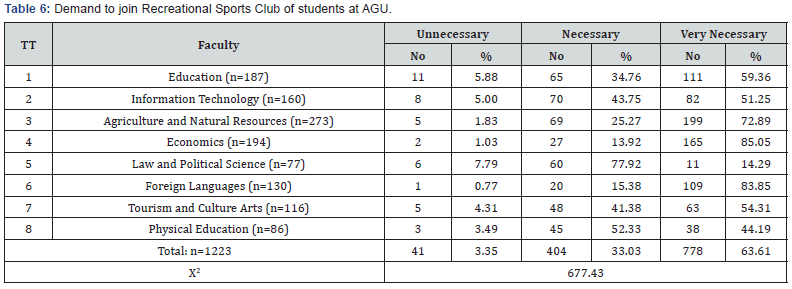The Actuality and Demand for Establishing Sports and Leisure Clubs for Students of a Giang University, Vietnam
Dao Chanh Thuc*
*Department of Physical Education, A Giang University, Vietnam
Submission: March 14, 2019; Published: April 01, 2019
*Corresponding author: Dao Chanh Thuc, Department of Physical Education, A Giang University, Vietnam
How to cite this article: Dao Chanh Thuc. The Actuality and Demand for Establishing Sports and Leisure Clubs for Students of a Giang University, Vietnam. J Phy Fit Treatment & Sports. 2019; 6(2): 555685. DOI:10.19080/JPFMTS.2018.05.555685
Abstract
The research results are an evidence about the necessity for the establishment of the Recreational Sports club model for students completing the physical education program at a Giang University in a Giang province. By analyzing methods of domestic and foreign documents, expert interviews, modeling, medical, physiological function tests, pedagogical experiment and statistical mathematics. The author has demonstrated the necessity for the establishment of the Recreational Sports club model at a Giang University with the specific, scientific and logical results among the research subjects.
Keywords: Necessity; Recreational Sports Club; Students a Giang University
Introduction
The training change from the year to the credit system of the University a Giang (AGU) is suitable with the development of higher education but it also deals with many difficulties such as organizing and managing the collective activities and extra-curriculum activities, especially extra-curriculum sport activities E Burton [1]. Studies were evaluated state and proposed solutions for the development of extra-curriculum physical education and sport activities. These activities have been studied by many authors who have contributed to improve the quality of extra-curriculum sport activities for students Thanh. However, these studies are only interested in the general orientations such as building the content and organizing extra-curriculum physical education and sport activities for students at university, giving solutions to develop extra-curriculum sport within the school, the effective training of students in sport clubs at residence Nguyen Gang [2]. They are only extra-curriculum sport activities temporarily and just to survey and evaluate the effective exercises of students in the school and other sport organizations Dao Chanh Thuc [3].
On the basis of the current regulations about the program framework of the Ministry of Education and Training, A Giang University has issued the physical education program for non-professional students with the following specific contents: Each student must perform 90 periods divided into 3 modules corresponding to first, second and third semester of the training process. If students just practice the main curriculums, they will not develop about physical fitness and skillful movements. With internalization state, it is said that the efficiency and quality of physical education is improved or not, depending on activities of the extracurricular Recreational Sports.
Research Methodology
The study was conducted through some methods, namely integrated research and relevant literature reviews, experts’ interview, modeling, pedagogical, medical and psychological examinations, pedagogical experiments and statistical mathematics.
Research Results
The State of forms of practicing physical education and sports and extracurricular recreation of students at A Giang University
To solve this problem, through the interview method (Anket) 1223 students of A Giang University consists of 608 men and 615 women. Do students themselves participate in sports training and extracurricular recreation? And if so, what forms can they join? Research results are presented in (Table 1). With the question “Yes or No” about participating in extracurricular recreational sports activities. 1223 students were asked, there are 725 answer with 59.28%. From the above results, the demand of practice physical education and sports and extracurricular recreation of students at A Giang University is very large; They take part in sports and extracurricular recreation with various types of training:

i. The Type of Individual Self-Training: There are 394 students’ answers with 32.22% and 34 specialized students’ answers with 34.53%.
ii. The Type of group Self-Training: There are 265 students’ answers with 21.67% and 14 specialized students’ answers with 1.14%.
iii. The Type of training in School’s Sports Teams: There are 111 answers with 9.08% of students of other faculties and with 1.39% specialized students.
iv. The Type of training in Recreational Sports Clubs at School: There are 24.45% of students in other faculties and 1.72% specialized students.
v. The Types of Training outside Sport Clubs: There are 14.72% of specialized students and 2.13% of other respondents.

In general, sports activities and extracurricular recreation of students at A Giang University are mainly in the form of self-training. Organized forms of sport and extracurricular recreation mainly practice in the sports teams of schools and faculties. There isn’t recreational sports club in the school and extracurricular physical education and sports and recreation activities at the socialist clubs outside A Giang University which are also spontaneous (Table 2).
Research on the state of training sports and extracurricular recreation of students at AGU
In order to have information about practicing sports activities and extracurricular recreation in the faculties of AGU, the study has conducted interviews with 1223 students at AGU (Table 3). The result statistical Dao Chanh Thuc [4] is presented in Table 3 shown that, over 1223 students were asked, there were 260 answers “Regular practice” with 21.26%, 662 answers “irregular practice “ with 54.13% and 301 answers completely without practice with 24.761%. In order to find out the reason why the number of people irregular and no practice with 78.74% of the total. The study has conducted a survey to find out the reason influenced to practice extracurricular recreational sports of students at AGU.


The Reasons Influenced to Practice Extracurricular Recreational Sports of Students at AGU
The study has conducted a survey with 1223 students at AGU, each student was asked to identify one or several reasons that they thought it was really affected extracurricular recreational sports activities in (Table 4). From the above results, the study has considered that there are many different subjective and objective causes that hinder practice extracurricular recreational sports of students at AGU such as family economic conditions or doing a part-time job. The causes of non-interest are also the reasons that have a small proportion (24.53%). The pressure of the training program is like equipping yourself a foreign language, information technology or second diploma and weather that are the reasons for relatively large proportions. Especially, lack or no yards and facilities are the basic reason that makes the practice extracurricular recreational sports activities limited and the rate of regular practice physical education and sports of students is still very low.
Demanding the Foundation of the Extracurricular Recreational Sports Club for Students in the Units of a Giang University
Through the survey results in Table 5 show that the number of students at AGU participates in extracurricular recreational sports activities about various types but mainly physical education and sports activities and extracurricular recreation by the self-practice form with 867 answers (70.89%). To step by step, build a suitable, feasible extracurricular recreational sports model, first of all, the study has to identify the necessity of practice physical education and sports and extracurricular recreation of students for this model. By the interview method over 1223 students of the units at AGU. The survey results in Tables 5 & 7 show that in 1223 students interviewed, there were 867 agreements with 70.89% “The foundation of the Extracurricular Recreational Sports Club”. This clearly reflects the adequate awareness about cultural spirit and physical fitness training and demonstrates serious demands when organizing, guiding and practicing physical education and sports.

Through the above research results, the study was found that there wasn’t a correlation between the state and the need to establish the Recreational Sports Club. The necessity of training sports and extracurricular recreation for students at AGU is very urgent. However, the units in AGU have not been able to establish the Recreational Sports Club because of the lack of basic conditions to organize Sports and Extracurricular Recreation activities especially, facilities and professional staffs. To survey the necessity of the establishment Recreational Sports Club, the study has conducted to find out the necessity of training the favorite Recreational Sports activities of students to organize activities in the club. The survey with 11 subjects includes the subjects that are being conducted in the physical education program such as volleyball, table tennis, football, handball, basketball, badminton, shuttlecock, chess, martial arts and some other sports are widely developing in the city such as gym, Fitness, swimming pool. Each student is selected one or several favorite subjects.


The survey results in Table 6 about selection of sports in 11 subjects with the following result: Football (33.20%), volleyball (37.12%), Handball (29.60%), Badminton (33.28 %), Shuttlecock (16.19%), table tennis (16.27%), chess (14.23%) and basketball (19.54%).Especially, Martial arts (Karate) and GYM are selected the most by students with Martial arts (57.24%) and GYM (59.53%), because of investing about good gym rooms at AGU. From analyzing the research results (Table 6), Experts’ AGU, scientists and managers of culture and sports and other sports departments said that the necessity of the establishment of the Recreational Sports Club for students is absolutely essential. In order to make effectively the model of Recreational Sports Club, the study has conducted the survey about 1223 students, the result is presented in (Table 7).
From the research results above, the study is found that the favorite Recreational Sports subjects are mostly in the main curriculum of students which have good training conditions. Annually, these subjects are held traditional competitions of A Giang province (outside GYM). According to the average of the percentage of 3 interviewed groups, there are 7 subjects selected relatively homogenous. Thus, there are 7 sports subjects which are interested in choosing the establishment of the Recreational Sports club at AGU including GYM, karate, volleyball, basketball, Taekwondo, aerobics and billiards.
Some Benefits when establishing Recreational Sports club for students at AGU: To consider the benefits when organizing the Recreational Sports Club, the study has conducted interviews with 20 professionals, 38 experts of AGU, 20 experts about sports, 23 leaders of the provinces about sports department and the managers and coaches of the Recreational Sports organizations about the benefits will gain when implementing, including:
i. Equipment.
ii. Instructions for training.
iii. Number of trainees.
iv. School fees.
v. Legal basis
The result is presented in Table 8 All the interview contents were got the convincing result (99.03%). Thereby, the study has found that, if implementing the Recreational Sports Club, it will ensure some advantageous conditions to organize Extracurricular Recreational Sports activities for trainees (Table 9).


Conclusion
About the state of training Recreational Sports club of students at AGU: The Extracurricular Recreational Sports activities of students now are mainly in the form of selftraining activities (32.22%) and (21.67%); The Extracurricular Recreational Sports activities are mainly organized and guided by teams of schools and faculties (9.08%), spontaneous clubs (24.45%) and at sports socialization facilities in and outside AGU (14.72%). In recent years, the number of people practicing sport at the clubs of A Giang University has increased dramatically, typically in GYM, fusal, volleyball, Karate. However, the number of participants is very low in comparison with the population in the area [5].
The results of Physical Education and Sports and extracurricular recreation of students at AGU are the same with the remarks of Nguyen Gang [2]. In his research, he judged that “Students of universities in Hue City mostly train without guidance. Nguyen Duc Thanh [6], also judged: “Most students in universities in Ho Chi Minh City train without guidance too”. The research results of Tran Kim Cuong commented: “The rate of students participating in training sports and extracurricular recreation is still very low (15%)”. The research results with primary school students of author Nguyen Ngoc Viet [7] also commented: “Sports activities and extracurricular recreation are also spontaneous, not regular and not systematic, mainly practiced according to season, freedom and no training instructions”. Thus, the general state in extracurricular recreational sports activities at different levels is not the guidance and this is one of the factors that makes extracurricular recreational sports activities of students not develop.
Discussion
About the state of training recreational sports of students at AGU: The research results in Table 3 reflect the reality of the number of students who regularly practices sports and recreation with 21.26%. This result is similar to the research of author Nguyen Gang [2], about the state of training extracurricular sports of students at Hue University (21.00%). This result is lower than the number of regular trainees in Ho Chi Minh City (22.40%) and the whole country (27.20% in 2013), the number of students who regularly practices sports at AGU is very low. The above research results are similar to the comments of author Tran Thi Xoan [8]: “The forms of extracurricular sports activities are now very diverse but generally not regular and have not become a habit among females’ students in Can Tho University”. The number of students doesn’t completely practice and occasionally practices with 78.74%. Through this issue, it can be seen that there are many subjective and objective reasons that make the training physical education and sports and recreation not become a habit and passion in students. With political stability, socio-economic development has created a premise for the development of the sports career and entertainment needs. The demand of mobility in life of people and especially students are increasing. A great benefit for recreational sports clubs outside is good coachs and instructors. At present, a large number of individuals with professional training qualifications after graduation, they also participate in training at recreational sports clubs’ outsides [9-11].
References
- Elissa Burton (2009) Organizational effectiveness in selected grassroots sport clubs in Western Australia.
- Nguyen Gang, Dao Chanh Thuc (2015) Studying and building linked physical education and sport club model between Hue university and other sport organizations in the Hue city. Doctor thesis (In Vietnam).
- Dao Chanh Thuc, Nguyen Van Tang (2018) Studying and Building Linked Physical Education and Sport Club Model Between a Giang University and Other Sport Organizations in The Long Xuyen City of a Giang Province. International Journal of Scientific & Engineering Research 9(4): 974-982.
- Dao Chanh Thuc (a) (2018) Solutions for Development and Expansion of Physical Education and Sport Clubs at A Giang University-Viet Nam. Journal of Physical Education Research 5(2): 57-62.
- Dao Chanh Thuc (b) (2018) Measurement in sports. LAP LAMBERT Academic Publishing.
- Nguyen Duc Thanh (2013) Building the content and organization of extra-curricular physical education and sport activities of students at Universities in Ho Chi Minh City. Doctor thesis (In Vietnam).
- Nguyen Ngoc Viet (2006) Theoretical basis for building extracurricular sports activities model There are guidelines for elementary students, Sports Science Journal (6), Institute of Sports Science, Hanoi, Vietnam p. 37-42.
- Tran Thi Xoan (2006) Research and develop extracurricular sports forms suitable for female students of Can Tho University, Master thesis, Sports University II (in Vietnam).
- Benjamin D Smith (2008) Motivational factors for student participation in collegiate club sport at Indiana University.
- Chrysostomos Kipouros (2011) Sport Marketing: Operational Structure - Foundation and Operation.
- Pham Tat Thang (2002) Research on the effectiveness of the application physical education and sport club activities perfectly for students of Hanoi Foreign Languages University. Master thesis. (In Vietnam).






























